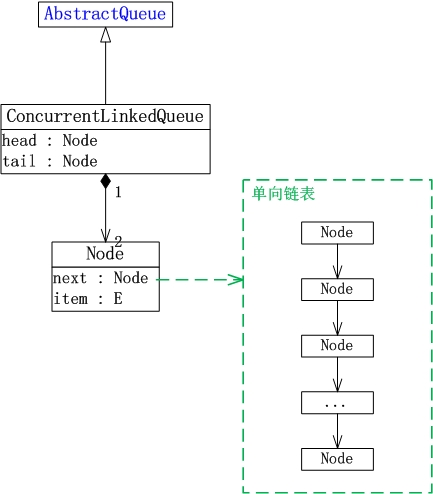一、概述
ConcurrentLinkedQueue是线程安全的队列,它适用于“高并发”的场景。
它是一个基于链接节点的无界线程安全队列,按照 FIFO(先进先出)原则对元素进行排序。队列元素中不可以放置null元素(内部实现的特殊节点除外)。
1.1、原理和数据结构

说明:
1. ConcurrentLinkedQueue继承于AbstractQueue。
2. ConcurrentLinkedQueue内部是通过链表来实现的。它同时包含链表的头节点head和尾节点tail。ConcurrentLinkedQueue按照 FIFO(先进先出)原则对元素进行排序。元素都是从尾部插入到链表,从头部开始返回。
3. ConcurrentLinkedQueue的链表Node中的next的类型是volatile,而且链表数据item的类型也是volatile。关于volatile,我们知道它的语义包含:“即对一个volatile变量的读,总是能看到(任意线程)对这个volatile变量最后的写入”。ConcurrentLinkedQueue就是通过volatile来实现多线程对竞争资源的互斥访问的。
1.2、示例
/* * ConcurrentLinkedQueue是“线程安全”的队列,而LinkedList是非线程安全的。 * * 下面是“多个线程同时操作并且遍历queue”的示例 * (01) 当queue是ConcurrentLinkedQueue对象时,程序能正常运行。 * (02) 当queue是LinkedList对象时,程序会产生ConcurrentModificationException异常。 * */ public class ConcurrentLinkedQueueDemo1 { // TODO: queue是LinkedList对象时,程序会出错。 //private static Queue<String> queue = new LinkedList<String>(); private static Queue<String> queue = new ConcurrentLinkedQueue<String>(); public static void main(String[] args) { // 同时启动两个线程对queue进行操作! new MyThread("ta").start(); new MyThread("tb").start(); } private static void printAll() { String value; Iterator iter = queue.iterator(); while (iter.hasNext()) { value = (String) iter.next(); System.out.print(value + ", "); } System.out.println(); } private static class MyThread extends Thread { MyThread(String name) { super(name); } @Override public void run() { int i = 0; while (i++ < 6) { // “线程名” + "-" + "序号" String val = Thread.currentThread().getName() + i; queue.add(val); // 通过“Iterator”遍历queue。 printAll(); } } } }
结果说明:如果将源码中的queue改成LinkedList对象时,程序会产生ConcurrentModificationException异常。
1.3、使用场景
二、源码分析
方式